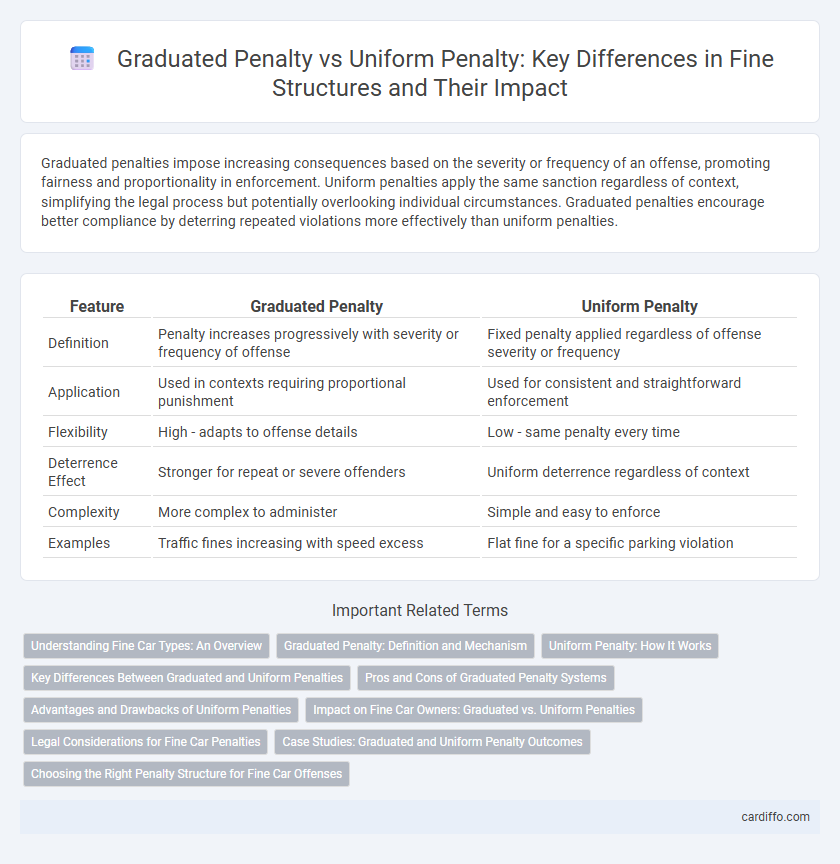Graduated penalties impose increasing consequences based on the severity or frequency of an offense, promoting fairness and proportionality in enforcement. Uniform penalties apply the same sanction regardless of context, simplifying the legal process but potentially overlooking individual circumstances. Graduated penalties encourage better compliance by deterring repeated violations more effectively than uniform penalties.
Table of Comparison
| Feature | Graduated Penalty | Uniform Penalty |
|---|---|---|
| Definition | Penalty increases progressively with severity or frequency of offense | Fixed penalty applied regardless of offense severity or frequency |
| Application | Used in contexts requiring proportional punishment | Used for consistent and straightforward enforcement |
| Flexibility | High - adapts to offense details | Low - same penalty every time |
| Deterrence Effect | Stronger for repeat or severe offenders | Uniform deterrence regardless of context |
| Complexity | More complex to administer | Simple and easy to enforce |
| Examples | Traffic fines increasing with speed excess | Flat fine for a specific parking violation |
Understanding Fine Car Types: An Overview
Graduated penalties in fine systems adjust the amount based on the severity or frequency of the offense, promoting fairness and deterrence by scaling consequences appropriately. Uniform penalties assign a fixed fine amount regardless of circumstances, simplifying enforcement but potentially lacking sensitivity to offender context. Understanding these fine structures assists legal professionals and policymakers in designing effective penalty frameworks for traffic violations or regulatory infractions.
Graduated Penalty: Definition and Mechanism
Graduated penalty refers to a system where penalties increase incrementally based on the severity or frequency of an offense, promoting proportional accountability. This mechanism adjusts consequences through predefined scales or tiers, ensuring that minor infractions receive lighter sanctions while repeat or severe violations incur harsher penalties. Such structured escalation helps tailor punitive measures to individual cases, improving fairness and deterrence compared to uniform penalty systems.
Uniform Penalty: How It Works
Uniform penalty applies a consistent rate or cost across all infractions or violations, ensuring straightforward calculation and predictable outcomes. This approach eliminates variability by imposing the same financial or corrective measure regardless of the severity or frequency of offenses. Uniform penalties are often favored for their simplicity in legal frameworks and compliance enforcement, streamlining administrative processes.
Key Differences Between Graduated and Uniform Penalties
Graduated penalties adjust the severity of punishment based on the seriousness or frequency of the offense, providing a scalable approach that aligns consequences with the degree of violation. Uniform penalties apply a fixed punishment regardless of circumstances, ensuring consistency but potentially lacking fairness in varied cases. This distinction impacts legal and regulatory frameworks by balancing flexibility with predictability in enforcement.
Pros and Cons of Graduated Penalty Systems
Graduated penalty systems offer the advantage of proportionality by imposing penalties based on the severity or frequency of offenses, which can promote fairness and incentivize behavior correction more effectively than uniform penalties. These systems enhance deterrence by escalating consequences with repeated violations, encouraging compliance while allowing first-time offenders more leniency. However, the complexity of administering varied penalties requires detailed record-keeping and may introduce challenges in ensuring consistent application and preventing perceived arbitrariness.
Advantages and Drawbacks of Uniform Penalties
Uniform penalties offer simplicity and ease of implementation by applying the same penalty rate regardless of the offense severity, leading to consistent enforcement and reduced administrative costs. However, this approach can lack fairness, as it may disproportionately impact minor infractions while insufficiently deterring more serious violations. The absence of graduated differentiation can result in ineffective deterrence and potential injustices in regulatory frameworks.
Impact on Fine Car Owners: Graduated vs. Uniform Penalties
Graduated penalties impose increasing fines based on severity or repeat offenses, incentivizing fine car owners to maintain compliance and reduce violations over time. Uniform penalties apply a fixed fine regardless of offense complexity, potentially leading to less deterrence among high-value vehicle owners who might perceive the fine as negligible. Studies show that graduated penalties enhance behavioral changes in fine car owners by aligning the financial impact more closely with the violation's seriousness.
Legal Considerations for Fine Car Penalties
Legal considerations for fine car penalties emphasize the balance between graduated and uniform penalty systems to ensure proportionality and deterrence. Graduated penalties adjust fines based on factors such as offense severity, repeat violations, and vehicle type, aligning with principles of justice and fairness. Uniform penalties provide straightforward enforcement but risk disproportionate impact on offenders, potentially raising concerns about equity under traffic law regulations.
Case Studies: Graduated and Uniform Penalty Outcomes
Case studies comparing graduated penalty and uniform penalty frameworks reveal significant differences in enforcement effectiveness and compliance rates across industries. Graduated penalty systems, which scale punishments based on violation severity or recurrence, tend to promote higher compliance by encouraging corrective actions and deterring repeat offenses more effectively than uniform penalties. In contrast, uniform penalties apply fixed sanctions regardless of context, often resulting in inconsistent deterrence and reduced incentive for incremental improvements in regulatory adherence.
Choosing the Right Penalty Structure for Fine Car Offenses
Graduated penalties for fine car offenses impose increasing fines based on the severity or frequency of violations, effectively deterring repeat offenders and promoting safer driving behavior. Uniform penalties apply a fixed fine regardless of offense context, simplifying enforcement but potentially lacking flexibility to address varied circumstances. Selecting the appropriate penalty structure involves balancing deterrence effectiveness, administrative efficiency, and fairness to ensure optimal road safety outcomes.
Graduated penalty vs uniform penalty Infographic

 cardiffo.com
cardiffo.com